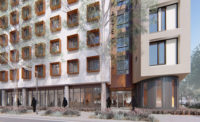It takes a lot of heat to make Portland cement, and the material releases carbon dioxide as part of a chemical reaction that occurs during the manufacturing process. Since concrete is mostly rock and sand bound together by Portland cement, the latter gives the global concrete industry a carbon footprint larger than that of the entire country of India.
A number of innovators are working to clean up the world’s leading building material by pumping it full of CO2. One such process—from Dartmouth, Nova Scotia–based CarbonCure—has already caught on with project teams, and a California-based competitor is hot on its heels with a complementary approach. Combined with some more established lower-tech tricks, these processes could trim concrete’s embodied carbon by over 80 percent.
CarbonCure’s process starts with CO2 captured from fertilizer and ethanol plants and purified primarily for use in carbonated drinks. But instead of carbonating sodas, CarbonCure’s process carbonates concrete. The CO2 is pumped into concrete mixers, where it chemically bonds with and becomes trapped in the concrete. That keeps the CO2 out of the atmosphere, but it also makes the concrete stronger. The latter delivers most of CarbonCure’s carbon benefit by reducing the amount of carbon-intensive Portland cement required to achieve a given pour’s specified compressive strength. “Every pound of CO2 sequestered reduces another 25 pounds [of embodied CO2] through cement reduction,” says Christie Gamble, CarbonCure’s senior director of sustainability.
Nearly 200 concrete plants in North America and Singapore use CarbonCure’s process, to date trapping or eliminating about 125 million pounds of CO2. Gamble attributes the technology’s adoption to its ability to cut embodied carbon without added cost, since savings from using less cement pay for the CO2 and CarbonCure’s license. “Almost every architect and engineer you talk to is interested in reducing environmental impact. When it’s cost-neutral, it becomes an easy sell,” she says.
Crucially, CarbonCure’s technology can be combined with the other means of trimming concrete’s footprint, such as replacing Portland cement with less carbon-intensive cementitious materials like fly ash from coal plants and steel slag. Cementitious supplements already displace about one-fifth of global cement demand, and experts say it could ultimately displace over two-thirds.
Juan Gonzalez, sustainability manager for operations at San Jose–based Central Concrete, says his firm routinely uses CarbonCure’s process with concrete mixes that have high ash and slag content. He points to the floors that Central Concrete poured last year for the SOM-designed new San Francisco law building at the University of California, Hastings. For that job they added CO2 to concrete with a 55:45 ratio of Portland cement to substitutes, cutting embodied carbon in half relative to conventional concrete.
Los Gatos, California–based Blue Planet, one of several teams chasing CarbonCure’s success, has a different cost-neutral scheme for cutting concrete’s embodied carbon. They also rely on industrial CO2, but instead of tweaking concrete’s need for cement, Blue Planet uses CO2 to create synthetic limestone that can sequester CO2 and replace aggregate—the quarried rock and sand used in concrete.
Blue Planet’s Bay Area pilot facility takes raw pollution streaming from a gas-fired power plant and reacts it with highly alkaline industrial wastes from, for example, cement kilns, mining operations, chemical plants, and demolished concrete. The reaction produces calcium carbonate—i.e., limestone—that is 44-percent sequestered CO2 by weight. The firm’s first commercial plant, in construction east of San Francisco, will produce enough aggregate to sequester up to 1 million tons of CO2 a year. It will offset more CO2 by reducing imports of rock quarried in far-off British Columbia.
Greg Kats, a Blue Planet board member and a sustainability consultant, says one bump in Blue Planet’s path is continued debate over how to quantify embodied carbon for materials that sequester CO2. Kats is working with the CSA Group, a Canadian standards body, to forge international guidance for concrete carbon disclosures.
What’s clear, says Kats, is that there is plenty of CO2 to work with. Power plants worldwide release enough carbon to meet global aggregate demand, says Kats. And both Blue Planet and CarbonCure imagine a future in which capturing the gigatons of CO2 released every year by cement plants worldwide further slashes concrete’s carbon footprint. Gamble says ongoing CarbonCure projects will “showcase that closed-loop concept” later this year.



Post a comment to this article
Report Abusive Comment